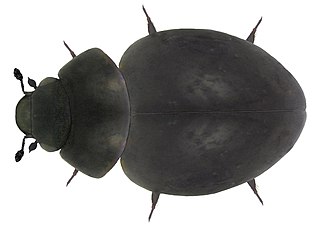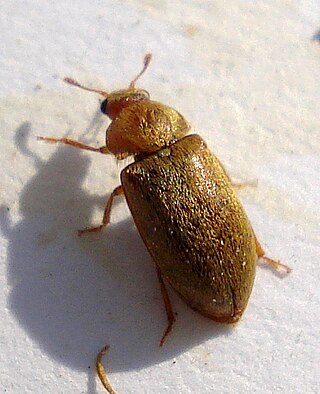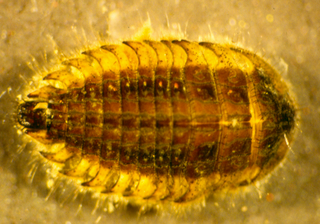
Sphaerius is a genus of beetles in the family Sphaeriusidae, comprising 18 species. It is one of the two extant genera in the family, the other being Bezesporum. They are typically found along the edges of streams and rivers, where they feed on algae; they occur on all continents except Antarctica. Three species occur in the United States.

The Hydroscaphidae are a small family of water beetles known commonly as skiff beetles. As of 2010, there are 23 species in the family. Several are recently described.

Myxophaga is the second-smallest suborder of the Coleoptera after Archostemata, consisting of roughly 65 species of small to minute beetles in four families. The members of this suborder are aquatic and semiaquatic, and feed on algae.

Ptinidae is a family of beetles in the superfamily Bostrichoidea. There are at least 220 genera and 2,200 described species in Ptinidae worldwide. The family includes spider beetles and deathwatch beetles.

Jacobsoniidae are a family of tiny beetles belonging to Staphylinoidea. The larvae and adults live under bark, in plant litter, fungi, bat guano and rotten wood. There are around 28 described species in three genera:

Nosodendridae is a family of beetles, with less than a hundred species in three extant genera, which are found worldwide. Nosodendron, the largest genus, is found in forests and attracted to yeast generated slime on the wounds of trees, and likely consumes fermented substances as well as fungi and microorganisms. Several additional genera and species are known from the fossil record. Nosodendridae is considered to be an isolated lineage within Polyphaga, being the sister group to the clade containing Staphyliniformia, Bostrichoidea and Cucujiformia.

Callirhipidae is a family of beetles, found widely throughout low-latitude regions except tropical Africa and Madagascar. There are around 175 species in 7 genera. The larvae bore into dead wood and generally have a life span of 2 or more years. The adults are generally nocturnal.

Lytta is a genus of blister beetles in the family Meloidae. There are about 70 described species in North America, and over 100 species worldwide.

Ceutorhynchini is a true weevil tribe in the subfamily Baridinae.

Macrocoma is a genus of leaf beetles in the subfamily Eumolpinae. It contains about 100 species, which are found in tropical Africa, around the Mediterranean, on the Canary Islands, in western and central Asia, and in India.
Phyllotrox is a genus of true weevils in the beetle family Curculionidae. There are at least 60 described species in Phyllotrox.

Byturus is a genus of fruitworm beetles in the family Byturidae. There are five described species in Byturus.

Ectopria is a genus of water penny beetles in the family Psephenidae. There are about nine described species in Ectopria.
Colecerus is a genus of broad-nosed weevils in the beetle family Curculionidae. There are about nine described species in Colecerus.

Thanatophilus is a genus of carrion beetles in the family Silphidae. There are about 12 described species in Thanatophilus.

Scirtes is a genus of marsh beetles in the family Scirtidae. There are more than 80 described species in Scirtes.

Hydroscapha natans is a species of skiff beetle in the family Hydroscaphidae. It is found in North America.

Bromiini is a tribe of leaf beetles in the subfamily Eumolpinae. The tribe contains approximately 120 genera, which are found worldwide. They are generally thought to be an artificial group, often with a subcylindrical prothorax without lateral ridges and covered with setae or scales.
Megarthrus is a genus of beetles belonging to the family Staphylinidae.
Hydroscapha jaechi, is a species of skiff beetle endemic to Sri Lanka.















